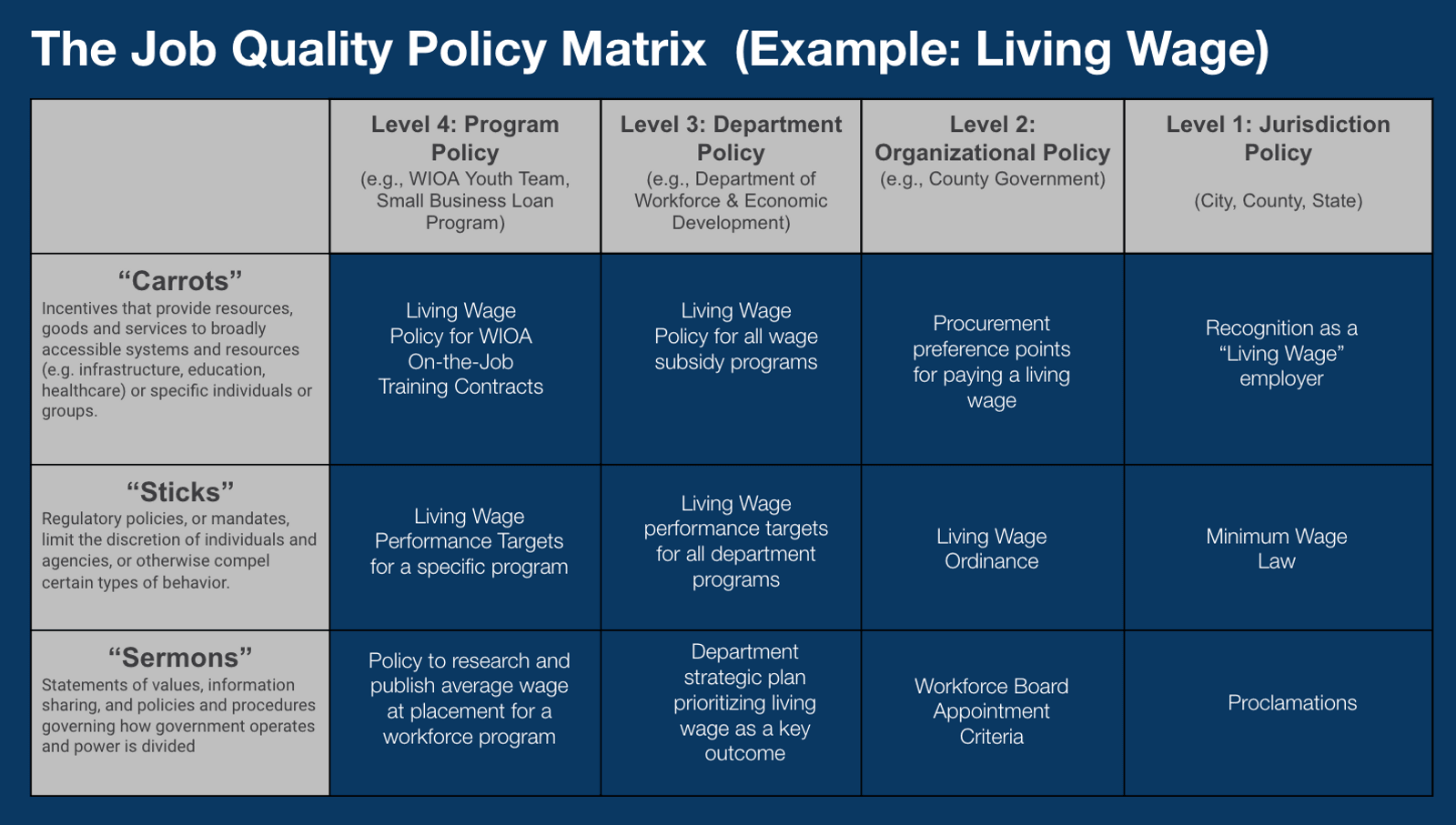While there are many different models, definitions, and ways to think about public and social policy, one framework comes from the political scientist Ray Rist outlined in the book Carrots, Sticks and Sermons: Policy Instruments and Their Evaluation. This framework outlines three types of policy tools at government’s disposal to influence individuals and organizations living or operating in their jurisdiction:
- Carrots refer to economic incentives
- Sticks refer to requirements and regulations
- Sermons on information, values, and processes.
The scope and jurisdiction an existing or planned policy action will affect can be be described as the policy level. For example, policies can direct action and priorities at the program or department level, the organization or agency level, or for an entire community or jurisdiction.
Level 1 - Program Policies: Formalized processes and procedures dictating how funds are used, who is eligible for the program, how the program operates, compliance guidelines, funding stream requirements, and other formalized rules, regulations, and priorities influencing a specific program. These policies are often contained in program handbooks, formal guidance or directive letters, contracts, and other program-specific documents.
Level 2 - Department Policies: Formalized processes and procedures guiding the priorities and operations of the department that oversees multiple funding streams and programs. This might include a department handbook, strategic plan, department operations manual, department charter, or other department-wide formal policy documents.
Level 3 - Organizational Policies: Charters, by-laws, strategic plans, operation manuals, code of regulations, and other policy documents that govern how an entire state, county, city, or other government entity operates.
Level 4 - Jurisdiction Policies: Laws, ordinances, regulations, and other policy tools that may impact all of the people living or organizations operating in the community. Jurisdiction often refers to city, county or state but may also be applied to a specific neighborhood or zone such as a Justice40 community.
To use the policy lever, consider what level of policy you wish to implement or change and then determine if it is within your scope of control.
The matrix below includes the “type of policy” on the left hand column and the different public policy types (regulatory, distributive, redistributive, and constituent) with the different levels that government agency leaders typically control or influence public policy (department, agency, jurisdiction).
While this is not a comprehensive review of every job quality policy intervention, it can be a helpful device to narrow in on if, how and at which level your project might interact, influence, or directly change policies that can impact job quality for workers in your community.

Using Policy to Support or Advance Job Quality Through Employers
Governments can use policies to help employers advance job quality within their organization by considering opportunities to educate, incentivize or require job quality principles at each point of connection. For example, job quality standards can be included in:
- Licensing and Renewals Processes
- Permitting Process
- Consumer Protection Policies
- Procurement and Purchasing Processes - see more in the Procurement lever
- Environmental Protection Policies
- City or State Tax Policies
- Public Service or Infrastructure Use Policies
- Loan / Capital Access Processes
Each of these existing processes offers opportunities to educate businesses about job quality, offer job quality related services (such as process reviews or benchmarking assessments) or implement job quality-related data collection requirements.
Other Considerations
It is important to acknowledge that policy change seldom occurs in a black box. In other words, other external forces, programs, and agendas may be occurring simultaneously. While this is unavoidable, be aware of the current state prior to designing, implementing or drawing conclusions from the data collected.
Additionally, prior to launching a new policy, take time to inventory your program, agency or jurisdiction’s capacity, expertise and bandwidth to design and build the necessary data infrastructure required to support effective measurement. This may involve integrating data sets, implementing new software, overseeing changes to data entry protocols or providing executive-level leadership to help turn information into insights.
Finally, look for ways to engage a diverse set of workers (depending on the level of the policy change this might be employees, participants, partners or even local residents) in the development of not only the policy itself but the implementation and evaluation approach. For more information on engaging and empowering individuals to participate, see the Empowerment lever.
Policy, regardless of the level (program, department, organization, or jurisdiction) is validated through the accomplishment of the policy objectives. Policy objectives should be defined through the development of a detailed logic model which lays out the key performance indicators (outcomes and impact) which the policy seeks to address. Measurement should then focus on changes that have occurred since the implementation of a policy and consider the extent to which changes can be attributed to the policy.
Policies and standards will have the the most impact when they are coupled with worker education programs, to ensure workers are equipped to advocate for their rights, and strong monitoring, enforcement and co-enforcement functions to assure compliance. See the Education and Enforcement lever to learn more.
Set goals and measure your success
There are powerful tools available to define your desired impact.